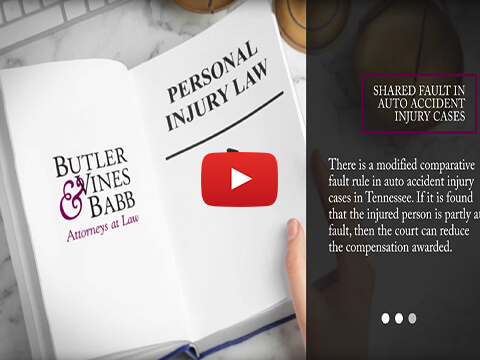If you have been injured in an auto accident, one of the keys to successfully collecting compensation will be proving that the other driver is the one at fault. In Tennessee, and most other states, determining fault must be done before any judgment on potential damages can be made. An experienced auto accident injury lawyer in Knoxville can help you obtain proof of the other driver's fault.
Auto Accident Injury Caused by Drunk Drivers
In some cases, determining fault can be relatively easy. For example, if a drunk driver hits you, it is instantly clear that the driver is at fault because driving while impaired by alcohol is negligent behavior. According to data from NHTSA, approximately one-third of auto accident deaths involve drunk drivers! That's the equivalent of one death every 52 minutes! In Tennessee, the limit for blood alcohol level, or BAC, is 0.08% at the time of driving. However, as shown below, even a lower amount can impair your driving ability.
- At 0.02% BAC, there is a decline in visual functions and multitasking ability.
- At 0.05% BAC, You have reduced coordination, difficulty steering, and slower response times to emergencies.
- At 0.08% BAC, which is the limit at which you are driving illegally, you will experience a decrease in concentration, speed control, and information processing along with short-term memory loss and impaired perception.
- At 0.10% BAC, reaction times deteriorate, and you have a reduced ability to maintain lane position and brake appropriately.
- At 0.15% BAC, there is substantial impairment in your ability to control a vehicle, decreased attention, and inability to process visual and auditory information.
However, it is not always so simple in other cases, and you will need the help of an auto accident injury lawyer in Knoxville to help obtain proof that shows who was at fault.
Types of Evidence to Prove Fault
There are a few ways that an auto accident injury lawyer in Knoxville can help obtain proof to determine fault. Let's take a look at some of the most common types:
1 - No-Doubt Liability
As mentioned above, cases involving a drunk driver who is considered at fault are usually straightforward. However, some other situations are considered a 'no-doubt' liability. The insurance provider is unlikely to argue who was at fault in these cases. The most common examples would be a rear-end collision and a left-turn accident. When you are hit from behind, it is usually always the driver's fault behind you. It is one of the most basic rules of the road that you are able to stop safely, even if you have to do so abruptly. There are a few exceptions; for example, if driving at night and your brake lights are out, you may be given a portion of the blame for the driver being unable to stop in time. In the case of left-turn accidents - i.e., where you are driving straight and someone making a left turn hits you - the turning car would be held responsible unless you were speeding excessively or had run a red light.
2 - Police Reports
Another way that an auto accident injury lawyer in Knoxville can obtain proof of who is deemed to be at fault is through official police reports. When an auto accident occurs, police will file a report detailing their findings from the scene. If there is an obvious fault, the report may state it. This might include mentions of traffic violations or careless driving. An auto injury lawyer in Knoxville can use this as evidence to prove that the other driver was at fault.
3 - Traffic Laws
Researching both State and Local traffic laws can be another way to support your claim that someone else is at fault. It may allow your auto accident injury lawyer in Knoxville to demonstrate that the other driver violated a specific law. The Tennessee Department of Transport has information regarding State Traffic Laws on their website, and you may also find information through your local library. Common terms to look out for will be clauses relating to speed limits, right of way, or road markings.
Shared Fault in Auto Accident Injury Cases
There is a modified comparative fault rule in auto accident injury and other personal injury cases in Tennessee. If it is found that the injured person is partly at fault, then the court can reduce the compensation awarded. For example, if you are rear-ended at a red light, but your brake lights are not working, the court may decide that you are 20% to blame and the other driver is 80% to blame. This means that the amount of damages awarded needs to be reduced by 20%. This applied up to 49% blame. If both parties are found to be 50% at fault, no compensation will be awarded. It would be best to discuss the potential for shared fault with your auto accident injury lawyer in Knoxville.
--

Butler, Vines and Babb is a leading law firm in Knoxville, TN, with extensive litigation experience in Medical Malpractice Law, Birth Injury Law, Trucking Accident Law, Personal Injury Law, and Business Law. Contact us today at www.bvblaw.com or call 865-637-3531.
Please reference BV&B’s content disclaimer (located in this channel’s profile description) in regard to this shared content.

